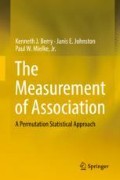Abstract
This chapter provides an introduction to the next nine chapters, a brief introduction to the two models of statistical inference—the population model and the permutation model. An overview of the remaining nine chapters concludes the chapter.
Access this chapter
Tax calculation will be finalised at checkout
Purchases are for personal use only
Notes
- 1.
There are two prominent statisticians with the surname Pearson: Karl Pearson, the father, and Egon S. Pearson, the son. Unless specified otherwise, in this book “Pearson” refers to Karl Pearson (1857–1936).
- 2.
The Neyman–Pearson population model is named for Jerzy Neyman (1894–1981) and Egon Pearson (1895–1980) and the Fisher–Pitman permutation model is named for Ronald Aylmer Fisher (1890–1962) and Edward James George Pitman (1897–1993).
- 3.
- 4.
Kelvins are named for Scottish physicist William Thomson, Lord Kelvin of Largs (1866–1892).
- 5.
The correlation ratio, η 2, was first described by Karl Pearson in 1911 and 1923 and later by R.A. Fisher in 1925.
- 6.
Technically, Pearson’s ϕ 2, Tschuprov’s T 2, Cramér’s V 2, and Pearson’s C are maximum-corrected measures of association under only certain highly restrictive conditions.
- 7.
For a somewhat different organization using nominal, ordinal, and interval scales, see a 1983 book by A.M. Liebetrau on non-permutation Measures of Association.
References
Agresti, A.: The effect of category choice on some ordinal measures of association. J. Am. Stat. Assoc. 71, 49–55 (1976)
Anderson, A.B., Balilevsky, A., Hum, D.P.J.: Missing data. In: Rossi, P.H., Wright, J.D., Anderson, A.B. (eds.) Handbook of Survey Research, chap. 12, pp. 415–479. Academic Press, New York (1983)
Berry, K.J., Mielke, P.W.: Extension of Spearman’s footrule to multiple rankings. Psychol. Rep. 82, 376–378 (1998)
Berry, K.J., Mielke, P.W., Johnston, J.E.: Permutation Statistical Methods: An Integrated Approach. Springer-Verlag, Cham, CH (2016)
Borgatta, E.F., Bornstedt, G.W.: Level of measurement—once over again. Sociol. Method Res. 9, 147–160 (1980)
Bornstedt, G.W.: Measurement. In: Rossi, P.H., Wright, J.D., Anderson, A.B. (eds.) Handbook of Survey Research, chap. 3, pp. 69–121. Academic Press, New York (1983)
Costner, H.L.: Criteria for measures of association. Am. Sociol. Rev. 30, 341–353 (1965)
Cowles, M.: Statistics in Psychology: An Historical Perspective, 2nd edn. Lawrence Erlbaum, Mahwah, NJ (2001)
Everitt, B.: Chance Rules: An Informal Guide to Probability, Risk, and Statistics, 2nd edn. Springer–Verlag, New York (2008)
Fernandes, P.: Don’t send us back to the closet. NY Times 166, A25 (11 May 2017)
Gaito, J.: Measurement scales and statistics: Resurgence of an old misconception. Psychol. Bull. 87, 564–567 (1980)
Goodman, L.A., Kruskal, W.H.: Measures of association for cross classifications. J. Am. Stat. Assoc. 49, 732–764 (1954)
Goodman, L.A., Kruskal, W.H.: Measures of association for cross classifications, II: Further discussion and references. J. Am. Stat. Assoc. 54, 123–163 (1959)
Goodman, L.A., Kruskal, W.H.: Measures of association for cross classifications, III: Approximate sampling theory. J. Am. Stat. Assoc. 58, 310–364 (1963)
Goodman, L.A., Kruskal, W.H.: Measures of association for cross classifications, IV: Simplification of asymptotic variances. J. Am. Stat. Assoc. 67, 415–421 (1972)
Leik, R.K., Gove, W.R.: Integrated approach to measuring association. In: Costner, H.L. (ed.) Sociological Methodology, pp. 279–301. Jossey Bass, San Francisco, CA (1971)
Liebetrau, A.M.: Measures of Association. Sage, Beverly Hills, CA (1983)
Lord, F.: On the statistical treatment of football numbers. Am. Psychol. 8, 750–751 (1953)
Luce, R.D., Krantz, D.H., Suppes, P., Tversky, A.: Foundations of Measurement, vol. 3. Academic Press, New York (1990)
Mielke, P.W., Berry, K.J., Johnston, J.E.: Resampling probability values for weighted kappa with multiple raters. Psychol. Rep. 102, 606–613 (2008)
Mortimer, I.: The Time Traveler’s Guide to Restoration Britain. Pegasus, New York (2017)
Mosteller, M., Tukey, J.W.: Data Analysis and Regression: A Second Course in Statistics. Addison–Wesley, Reading, MA (1977)
Pfanzagl, J.: Theory of Measurement. Wiley, New York (1968)
Stevens, S.S.: On the theory of scales and measurement. Science 103, 667–680 (1946)
Stevens, S.S.: Mathematics, measurement, and psychophysics. In: Stevens, S.S. (ed.) Handbook of Experimental Psychology, chap. 1, pp. 1–49. Wiley, New York (1951)
Thomson, W.: Popular Lectures and Addresses. MacMillan, London (1889)
Vellman, P.F., Wilkinson, L.: Nominal, ordinal, interval and ratio typologies are misleading. Am. Stat. 47, 65–72 (1993)
Weiss, R.S.: Statistics in Social Research: An Introduction. Wiley, New York (1968)
Wilson, T.P.: Critique of ordinal variables. Social Forces 49, 432–444 (1971)
Yule, G.U.: On the methods of measuring association between two attributes. J. R. Stat. Soc. 75, 579–652 (1912). [Originally a paper read before the Royal Statistical Society on 23 April 1912]
Author information
Authors and Affiliations
Rights and permissions
Copyright information
© 2018 Springer Nature Switzerland AG
About this chapter
Cite this chapter
Berry, K.J., Johnston, J.E., Mielke, P.W. (2018). Introduction. In: The Measurement of Association. Springer, Cham. https://doi.org/10.1007/978-3-319-98926-6_1
Download citation
DOI: https://doi.org/10.1007/978-3-319-98926-6_1
Published:
Publisher Name: Springer, Cham
Print ISBN: 978-3-319-98925-9
Online ISBN: 978-3-319-98926-6
eBook Packages: Mathematics and StatisticsMathematics and Statistics (R0)

